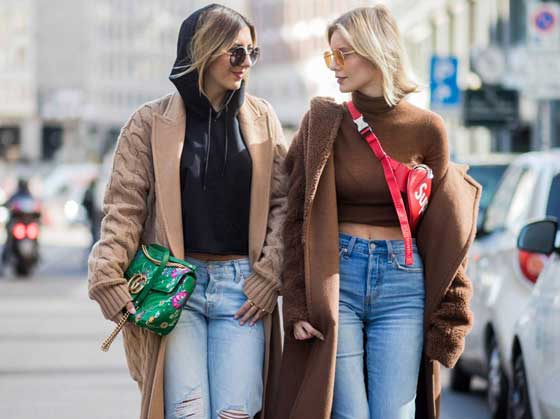
Following the chessboard manoeuvres of the global fashion brands – and their latest financial figures – one fact is so glaringly obvious that no one seems to mention it: the winning houses are mostly founded on accessories. And, to this day, that is where the money rolls in.
Louis Vuitton? Tick. The brand started with travel bags. Enter the boutiques now, and bags, shoes, and a smaller rack of scarves form the first and biggest impression. And the introduction of Virgil Abloh as Artistic Director of Menswear is a way of bringing fresh energy to the famous brand.
Gucci? Tick. Handbags, shoes, and accessories such as scarves and belts started the business – and whatever the excitement current Creative Director Alessandro Michele has created with his recent, quirky librarian looks, it is the torrent of accessories that is pushing the brand towards €10 billion in annual sales for the Kering group.
The same is true throughout the luxury industry, from Bottega Veneta (built on bags) to Prada (ditto), and although both are performing well, neither are reaching the stellar heights of their competitors.
Surely it is significant that a company founded on clothes, like the noble Balenciaga, is powering growth with passionately desirable sneakers (typical price, $700)? Meanwhile, Saint Laurent′s store windows and floors are filled with covetable handbags or focus on Creative Director Anthony Vaccarello′s high-rise yeti boots. They are decorated with the kind of ostrich feathers that Yves Saint Laurent himself once used to dress dancer and actress Zizi Jeanmaire.
On the minus side, British designer Christopher Kane, one of the great and original talents of the new millennium, is being let go by the Kering group. It seems that being a brilliant, artistic, and imaginative designer does not count anymore – unless you can back it up with a best-selling bag or shoe.
Against this background, I thought about two ready-to-wear shows that took place during the recent haute couture season.
Vetements, the brand founded by designer Demna Gvasalia and his management-based brother Guram, presented a cruelly tough show that told their own life story as two youths fleeing the civil war in Georgia in the 1990s. Although the brand had already acted as a disrupter of the smooth, high-end fashion of the new millennium, this Spring/Summer 2019 Ready-to-Wear show – held in the scruffy hinterland of a Paris motorway – threw a conceptual grenade at the opening of the couture collections.
Yet take away the coded messages – written in the Russian and Georgian alphabets – and remove the provocations of the hoodies and military balaclavas, the clothes themselves – and especially the accessories – exuded fashion identity. Shorn of their narrative, the collection was distilled to a sweet Russian-scarf print skirt and what have gone online as $700 sneakers.
If fashion has been reduced to objects rather than outfits of desire, Demna Gvasalia′s other day job as Creative Director of Balenciaga confirms the story. Although the designer has made his name on a distinct, hard-shouldered silhouette and way-beyond-oversized logo hoodies (both styles offered online), it is the $900 sneakers, with their waves of colour on an undulating base, that are so desperately sought-after by eager collector customers.
So has fashion been reduced to single object of desire produced under the name of a famous fashion house?
Not always. I arrived at the Hermes Resort collection for Spring/Summer 2019 at the absolute last minute, as I literally ran from a delayed Eurostar train. With no programme and barely time to draw breath, I watched Nadege Vanhee-Cybulski′s collection unfold – gracefully, colourfully, and with a distinct vision.
The designer gains confidence with each show and the first surprise was seeing flat beach sandals worn with everything from a tailored black coat to a smart navy silk dress. The clothes were fresh yet sophisticated, with vivid splashes of fresh tones, from leaf green through rust to yellow and orange. All these shades seemed to fit well with the company′s classy, sporty, horsey spirit.
Hermes is, of course, known for its leather, the luxury company having grown from its early days of hand-made saddles (which are still on offer) to upper-crust handbags like the Kelly. But the rebuilding of the company′s clothing category has never looked so convincing.
Nadege explained how she had studied paintings to develop the colours, and was even inspired by the lace used for Kate Middleton′s wedding dress, which encouraged her to introduce new and surprising materials.
"Actually, it was a good challenge," Nadege said, pointing to the lace and to signs of the zodiac that patterned leather pieces.
While most luxury houses seem to rest on their laurels and rely on growth in familiar areas, Hermes is pushing in various directions, for example fine jewellery.
Pierre Hardy, who also designs Hermes′ men′s and women′s footwear, presented jewels with a clean, clear angle, shown on stage by modern dancers. It seemed like a smart way to expand the offering, while keeping true to the spirit of Hermes.
"I think I am biased because I know Hermes – it is very intricate in the making, it has fabulous materials, an incredible palate of colours, and a very slim and elegant silhouette," said Pierre-Alexis Dumas, the family company′s Artistic Director. "How can Hermes be contemporary today? How can we give it a modern expression? Nadege is really answering that question. She is fluid and full of confidence, but it takes time. I have been working 25 years at Hermes and realise I still have a long way to go."